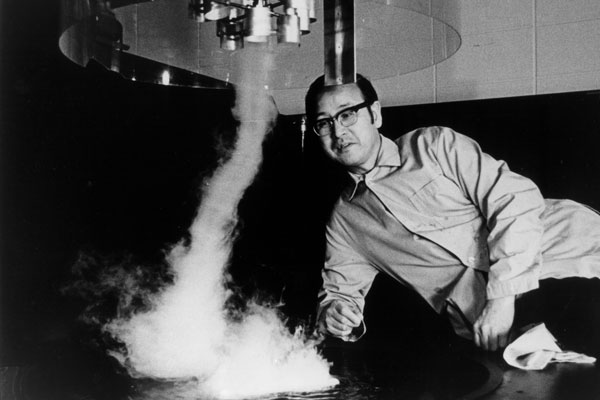
The news today has been dominated by the tornadoes that devastated the South yesterday; an estimated 250 people were killed, the first time in almost 40 years that more than 100 people have been killed by a tornado outbreak. That was the Super Outbreak of 1974, the most intense tornado outbreak on record, which generated 148 tornadoes from Alabama to Ontario and killed over 300 people. (The most deadly tornado outbreak was the one that generated the Tri-State Tornado, which alone killed 695 people in three and a half hours on March 18, 1925.)
In the wake of the Super Outbreak, a University of Chicago scientist named Ted Fujita, known in the meteorology business as "Mr. Tornado," spent ten months studying its aftermath in "the most extensive aerial tornado survey ever conducted." Only a couple years before, Fujita had developed his most famous contribution to the science, the F-scale (since revised, and now called the Enhanced Fujita Scale), which estimates wind speed from wind damage. The Super Outbreak allowed Fujita to apply it on an immense scale—a scale that’s never before or since existed. Here’s the map that resulted from Fujita’s months of research; the density of the tornadoes is incredible.
Tom Skilling argues that Fujita’s greatest scientific contribution is not the famous Fujita Scale, but his discovery of downbursts and microbursts, falling columns of cold air that can create tornado-like damage, or crash an airplane. It’s incredible: like a bucket a couple miles across being dumped out of the sky.
Fujita’s study of the Super Outbreak led to his discovery of microbursts, when he discovered patterns of damage that couldn’t be explained by tornadoes, as Fujita later wrote:
Throughout the past one half century, my hobby was to observe, measure and analyze data on damaging winds and their parent clouds, in an attempt to unlock the mystery of small but violent airflows which escape detection by conventional wind-measuring devices. Fortunately, my hobby was identical to my occupation under two single employers, the first in Japan and the second in the United States…. I flew over 40,000 km in a Cessna above the swaths of tornadoes in search of the damage caused by unidentified winds. The starburst patterns of uprooted trees found in forests led me to hypothesize the downburst/microburst winds which initiated a controversy lasting from the late 1970’s to the 1980’s.
When Fujita died in 1998, he was memorialized by his colleagues as having an exceptional gift for intuiting weather phenomena:
“From limited observations he would theorize how things work, and it often was left to the rest of us to come along and prove his theories,” said Jim Wilson, a senior scientist at the National Center for Atmospheric Research in Boulder, Colo. “There was an insight he had, this gut feeling. He often had ideas way before the rest of us could even imagine them.”
Fujita’s instinctive understanding of atmospheric phenomena is “just one of those things you can’t replace,” Wilson said. “He was a controversial character at times because of the way he did his science. But there was no question that he had insight that very few people had.”
But his stroke of insight about microbursts was born from tragedy. Fujita came of age in Japan during World War II, and might have died in the Hiroshima bombing had his father not insisted he attend college in Meiji, instead of Hiroshima, where Fujita preferred. When Nagasaki was bombed, Fujita was staying in Kokura, three miles away from the original target. Fujita likely would have been killed had cloud cover not diverted the bombing run to the secondary target.
A month after the bombings, Fujita, a mechanical engineer by training, was sent to study the aftermath:
At both bomb sites, Fujita noticed a giant starburst pattern directly beneath the explosions. The trees at Nagasaki were burned but still standing directly beneath the explosion. Likewise, a bridge that had been Enola Gay‘s target still stood. The outburst from the bombs flattened bamboo, pine trees, and steel poles in a circular pattern away from ground zero. He envisioned the explosion, the great white blinding ball of fire and an incredible woosh of winds that fell to the earth and spread outward in all directions.
In other words, just like a microburst. A year after the Super Outburst, Fujita would identify a downburst as the cause of a 1975 airplane crash, then the deadliest in U.S. history.
In more obscure Illinois tornado history, the first hook echo ever recorded on radar—a distinctive prelude to a tornado—was filmed in 1953 in Champaign by the Illinois State Water Survey.
Here’s the hook echo from the famous 1974 Xenia, Ohio tornado, part of the Super Outbreak, which inspired Harmony Korine’s film Gummo and was believed by Fujita to be the closest to a recorded F6 tornado he’d seen evidence of.
Photograph: University of Chicago


